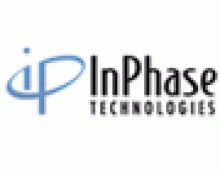
InPhase Technologies New Holographic Technique Enables Terabyte Disc Recording
InPhase Technologies announced today that it has successfully demonstrated a data density of 200 gigabits per square inch, significantly higher than any other optical format.
InPhase achieved this breakthrough by using its patented polytopic recording method, which will be implemented in all generations of the Tapestry drive family. The first generation drive, targeted at a 300 gigabytes (GB) capacity on a single disk, will be available in 2006. This will be followed a family of products ranging to 1.6 terabyte (TB) capacity in 2009.
Holographic storage delivers high capacity by recording data throughout the volume of the recording material, and not just on the surface. A data page of approximately 1 million bits is recorded in one exposure of the laser. Each data page is located at a unique address within the material and several hundred pages of data, each with their own unique address, are recorded in the same location of the medium. A collection of data pages is referred to as a book. This new recording technique enables more holograms to be stored in the same volume of material by overlapping not only pages, but also books of data. This dramatically increases the storage density.
This new recording method is implemented in conjunction with an optical architecture developed by InPhase, which uses optical lenses with a high numerical aperture (NA). The combination of the new recording method and high NA lenses results in a smaller page size that provides a 10X increase in achievable data density. This also increases the data transfer rate, and InPhase has demonstrated a transfer rate of 27 megabytes (MB) per second at density.
InPhase was able to deliver this latest innovation through a $2.77 million grant awarded in 2003 by the National Institute of Standards and Technology's (NIST) Advanced Technology Program (ATP). The purpose of the grant was to develop advanced holographic recording technology that would lead to the commercialization of the first 1 TB holographic data storage system. This grant was the second that InPhase had received from the ATP in 2002-2003. The Advanced Technology Program has been a critical source of funding for breakthrough technology developments that have the potentially broad economic benefits to the United States.
"The InPhase legacy of persistent invention has produced numerous breakthroughs on the road to commercial holographic recording systems. This will impact data storage options for consumers and professionals alike," said Kevin Curtis, chief technology officer of InPhase Technologies.
The density milestone was achieved using InPhase Tapestry blue media, which is sensitive to 407-nanometer wavelength, and has a recording material thickness of 1.5 mm. Approximately 1 million bits of data were recorded per page, and 252 pages were recorded in one book. A total of fifteen books of data were overlaid in one location.
InPhase is conducting the first public demonstration of a holographic prototype at the National Association of Broadcasters (NAB) convention in Las Vegas, April 18 through April 21, at the Maxell Corporation of America booth #C8530 in the central hall of the Las Vegas Convention Center. Hitachi Maxell Ltd. is both an InPhase investor and development partner.
Holographic storage delivers high capacity by recording data throughout the volume of the recording material, and not just on the surface. A data page of approximately 1 million bits is recorded in one exposure of the laser. Each data page is located at a unique address within the material and several hundred pages of data, each with their own unique address, are recorded in the same location of the medium. A collection of data pages is referred to as a book. This new recording technique enables more holograms to be stored in the same volume of material by overlapping not only pages, but also books of data. This dramatically increases the storage density.
This new recording method is implemented in conjunction with an optical architecture developed by InPhase, which uses optical lenses with a high numerical aperture (NA). The combination of the new recording method and high NA lenses results in a smaller page size that provides a 10X increase in achievable data density. This also increases the data transfer rate, and InPhase has demonstrated a transfer rate of 27 megabytes (MB) per second at density.
InPhase was able to deliver this latest innovation through a $2.77 million grant awarded in 2003 by the National Institute of Standards and Technology's (NIST) Advanced Technology Program (ATP). The purpose of the grant was to develop advanced holographic recording technology that would lead to the commercialization of the first 1 TB holographic data storage system. This grant was the second that InPhase had received from the ATP in 2002-2003. The Advanced Technology Program has been a critical source of funding for breakthrough technology developments that have the potentially broad economic benefits to the United States.
"The InPhase legacy of persistent invention has produced numerous breakthroughs on the road to commercial holographic recording systems. This will impact data storage options for consumers and professionals alike," said Kevin Curtis, chief technology officer of InPhase Technologies.
The density milestone was achieved using InPhase Tapestry blue media, which is sensitive to 407-nanometer wavelength, and has a recording material thickness of 1.5 mm. Approximately 1 million bits of data were recorded per page, and 252 pages were recorded in one book. A total of fifteen books of data were overlaid in one location.
InPhase is conducting the first public demonstration of a holographic prototype at the National Association of Broadcasters (NAB) convention in Las Vegas, April 18 through April 21, at the Maxell Corporation of America booth #C8530 in the central hall of the Las Vegas Convention Center. Hitachi Maxell Ltd. is both an InPhase investor and development partner.

















